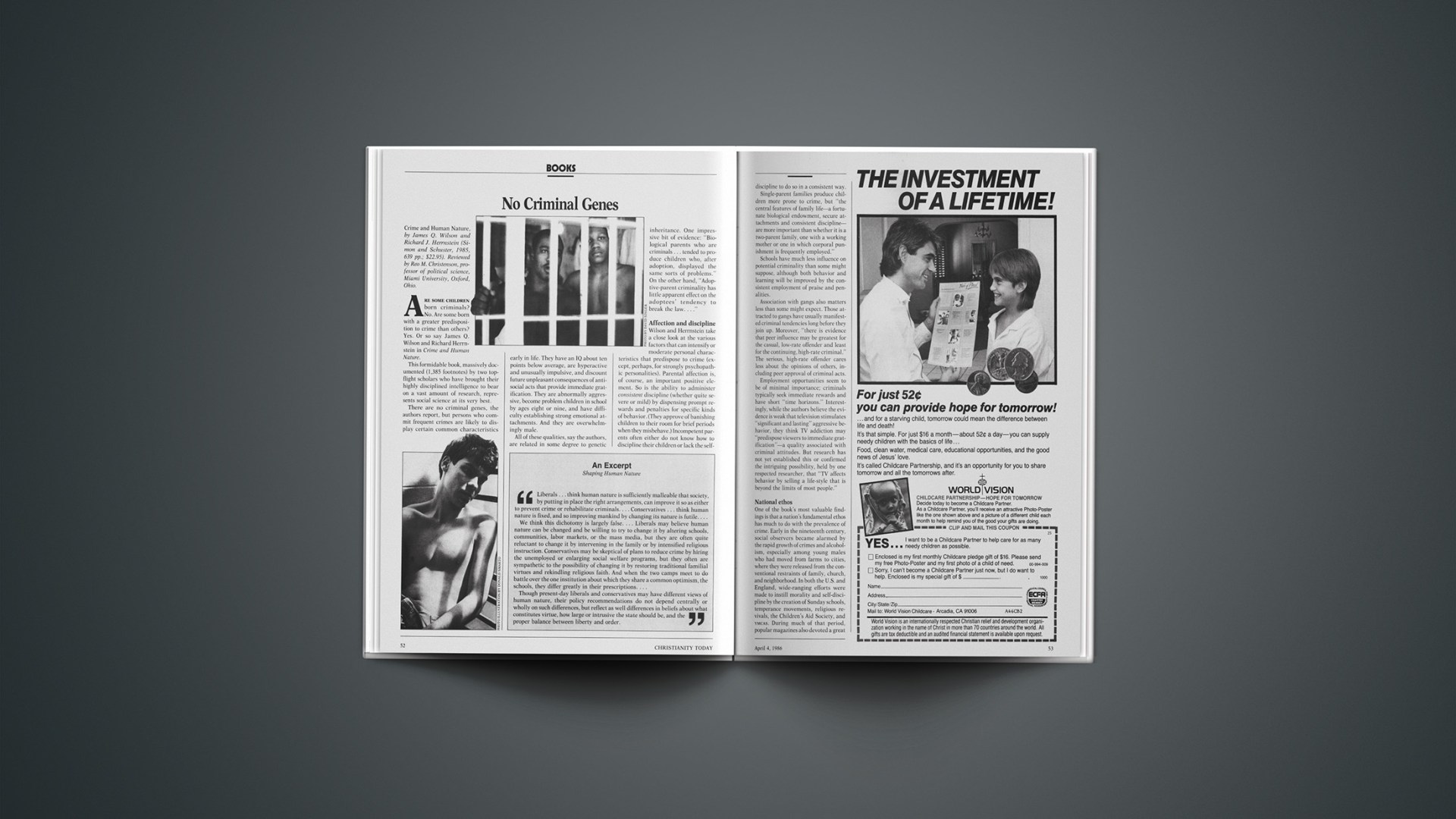Crime and Human Nature, by James Q. Wilson and Richard J. Herrnslein (Simon and Schuster, 1985, 639 pp.; $22.95). Reviewed by Reo M. Christenson, professor of political science, Miami University, Oxford, Ohio.
Are some children born criminals? No. Are some born with a greater predisposition to crime than others? Yes. Or so say James Q. Wilson and Richard Herrnstein in Crime and Human Nature.
This formidable book, massively documented (1,385 footnotes) by two topflight scholars who have brought their highly disciplined intelligence to bear on a vast amount of research, represents social science at its very best.
There are no criminal genes, the authors report, but persons who commit frequent crimes are likely to display certain common characteristics early in life. They have an IQ about ten points below average, are hyperactive and unusually impulsive, and discount future unpleasant consequences of antisocial acts that provide immediate gratification. They are abnormally aggressive, become problem children in school by ages eight or nine, and have difficulty establishing strong emotional attachments. And they are overwhelmingly male.
All of these qualities, say the authors, are related in some degree to genetic inheritance. One impressive bit of evidence: “Biological parents who are criminals … tended to produce children who, after adoption, displayed the same sorts of problems.” On the other hand, “Adoptive-parent criminality has little apparent effect on the adoptees’ tendency to break the law.…”
An Excerpt
Shaping Human Nature
“Liberals … think human nature is sufficiently malleable that society, by putting in place the right arrangements, can improve it so as either to prevent crime or rehabilitate criminals.… Conservatives … think human nature is fixed, and so improving mankind by changing its nature is futile.…
We think this dichotomy is largely false.… Liberals may believe human nature can be changed and be willing to try to change it by altering schools, communities, labor markets, or the mass media, but they are often quite reluctant to change it by intervening in the family or by intensified religious instruction. Conservatives may be skeptical of plans to reduce crime by hiring the unemployed or enlarging social welfare programs, but they often are sympathetic to the possibility of changing it by restoring traditional familial virtues and rekindling religious faith. And when the two camps meet to do battle over the one institution about which they share a common optimism, the schools, they differ greatly in their prescriptions.…
Though present-day liberals and conservatives may have different views of human nature, their policy recommendations do not depend centrally or wholly on such differences, but reflect as well differences in beliefs about what constitutes virtue, how large or intrusive the state should be, and the proper balance between liberty and order.”
Affection And Discipline
Wilson and Hermstein take a close look at the various factors that can intensify or moderate personal characteristics that predispose to crime (except, perhaps, for strongly psychopathic personalities). Parental affection is, of course, an important positive element. So is the ability to administer consistent discipline (whether quite severe or mild) by dispensing prompt rewards and penalties for specific kinds of behavior. (They approve of banishing children to their room for brief periods when they misbehave.) Incompetent parents often either do not know how to discipline their children or lack the self-discipline to do so in a consistent way.
Single-parent families produce children more prone to crime, but “the central features of family life—a fortunate biological endowment, secure attachments and consistent discipline—are more important than whether it is a two-parent family, one with a working mother or one in which corporal punishment is frequently employed.”
Schools have much less influence on potential criminality than some might suppose, although both behavior and learning will be improved by the consistent employment of praise and penalities.
Association with gangs also matters less than some might expect. Those attracted to gangs have usually manifested criminal tendencies long before they join up. Moreover, “there is evidence that peer influence may be greatest for the casual, low-rate offender and least for the continuing, high-rate criminal.” The serious, high-rate offender cares less about the opinions of others, including peer approval of criminal acts.
Employment opportunities seem to be of minimal importance; criminals typically seek immediate rewards and have short “time horizons.” Interestingly, while the authors believe the evidence is weak that television stimulates “significant and lasting” aggressive behavior, they think TV addiction may “predispose viewers to immediate gratification”—a quality associated with criminal attitudes. But research has not yet established this or confirmed the intriguing possibility, held by one respected researcher, that “TV affects behavior by selling a life-style that is beyond the limits of most people.”
National Ethos
One of the book’s most valuable findings is that a nation’s fundamental ethos has much to do with the prevalence of crime. Early in the nineteenth century, social observers became alarmed by the rapid growth of crimes and alcoholism, especially among young males who had moved from farms to cities, where they were released from the conventional restraints of family, church, and neighborhood. In both the U.S. and England, wide-ranging efforts were made to instill morality and self-discipline by the creation of Sunday schools, temperance movements, religious revivals, the Children’s Aid Society, and YMCAS. During much of that period, popular magazines also devoted a great deal of attention to character development. Although that was a period of rapid industrialization and urbanization (normally associated with rising crime), both crime and alcoholic consumption fell sharply.
After 1920, cultural leaders shifted their emphasis from self-control to self-expression. Tolerance, individualism, and personal freedom became primary values to be encouraged; rights rather than responsibilities were stressed. And even though the racial and economic opportunities of the sixties and seventies were favorable, and far more money was being spent on education and job training, crime rose dramatically.
Crime and Human Nature has a fascinating section on Japanese culture and the low crime rate it yields. The Japanese are not a very religious people; the following social characteristics seem relevant: a highly homogeneous population; the presence of a “village atmosphere” within large cities, with neighbors knowing one another; a deemphasis of individualism and personal rights but an emphasis upon one’s obligations to family and employer; an IQ about ten points higher than in the U.S. (Higher intelligence seems to enable people more easily to develop concern for the long-term consequences of their actions).
Missing Information
Of special interest to readers of CT, the authors note that “of all the gaps in our knowledge of the causes of crime, the one that has struck us most forcefullly is the lack of systematic studies of the relationship between religiosity and criminality.”
A belief that some people are more crime prone than others poses problems for Christians who believe in a just God. But these problems are no greater than those they have long grappled with. That life is “unfair” is hardly a novel concept. Christians may need to settle for the assumptions that all accounts are not settled in this life and—as someone has said—“Let us never dismiss the possibility that God just may know what he is doing.”
Meanwhile, parents would do well to heed Wilson and Herrnstein’s advice about consistent family discipline. They would also be prudent to pressure the entertainment industry to reflect on what Crime and Human Nature has to say about what happens when self-expression and individualism have supremacy over self-mastery.










